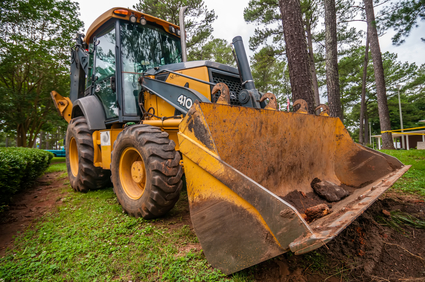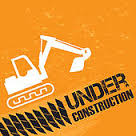![]()
FIRST VEGETABLE GARDEN
RAIN GARDENS
THE OZ VICTORY GARDEN
GARDENING TO SAVE MONEY
INCREASE YOUR BOTANY SAVVY
TILLING VS CULTIVATING
THE PERILS OF PEAT
THE DIRT ON SOIL
TINES, TINES, TINES
WHY AND HOW TO TILL
RENT OR BUY
HOW TO RENT & USE A BACKHOE
FALL LANDSCAPING TIPS
ECO FRIENDLY TIPS
USING GOOD PESTS TO FIGHT BAD PESTS
BUYING A LAWN MOWER?
TILLER CARE
COMPOSTING 101
MY NEW TILLER
AWARENESS WEEK
![]()
INTRODUCTION
SMALL TILLERS
MEDIUM TILLERS
LARGE TILLERS
HAND CULTIVATORS
WEBSITE REVIEWS
![]()
ABOUT THIS SITE
CONTACT OZ
CONTRIBUTION
JOIN THE DISCUSSION
RECOMMENDED READING
THE OZ BOOK STORE
How to Use a Backhoe for Excavating Your Backyard
If you're like me, sometimes you find the job at hand is just to big and your euipment too small to get the job done right. Although large construction equipment requires special training and experience for safe and effective operation, you don’t need to be a construction expert to rent and operate a backhoe for your weekend home improvement projects. Getting a demonstration of the equipment, having the operation manual on hand to refer to and adhering to safety procedures ensure that you can successfully use a backhoe to dig and move dirt for your project.
Excavation Projects with Backhoes
Used properly, backhoes help you to complete big jobs quickly without the manual effort of physically digging and lifting. With an auger attachment, you can use a backhoe to quickly dig large, deep fence post holes. A hydraulic hammer attachment enables you to quickly break up cement on broken patios or sidewalks. A backhoe operator with a toothed bucket can dig out a large area for a pond or swimming pool installation, or prepare several large, deep holes to plant trees or shrubs for landscaping.
 |
Backhoe Safety Precautions and Procedures
While backhoes come in different sizes, even small backhoe rentals are heavy equipment that requires safe operation to avoid injury and property damage. The basics of properly and safely operating a backhoe are as follows:
-
Check with utilities and municipalities before any excavation project to know location and depth of pipes and cables and other buried utilities.
-
Clearly premark the excavation area to keep people and animals out during machine operation. Use white paint, stakes or other white markings such as signage and mark the entire perimeter of the area to be excavated.
-
Inspect the backhoe before operating for loose parts, leaks and excessive wear. Look at hoses, connectors, hydraulic cylinders, hinge pins and bushings, teeth on the bucket and all welds. Check for leaks, bent or missing pieces, cracks and chips.
-
Inspect the engine before operating and test the backup alarm. Look into the engine area and visually inspect for leaks, and loose hoses and belts. Check underneath the engine for leaks or parts that have dropped. Put the machine into reverse without any load in the bucket to see if the backup alarm goes off.
-
Use the right bucket size for the project and space. Larger spaces with a lot of area to maneuver can accommodate medium to large backhoes and buckets. Small, tighter spaces require smaller, sub-compact equipment with small buckets. Always use all safety attachments such as safety chains, seatbelts, and frame lock levers and stabilizers.
-
Know the specifications for lifting loads (how much the machinery can safely lift and move without tipping over) and perform a test lift before beginning operations. Find this information in the equipment manual, which you should read before operating.
-
Don’t transport a loaded bucket that is raised high – keep the full bucket as low as possible when moving materials. Only raise the bucket to full height when the equipment is stopped and stabilized at the excavation area to lift and dump. If you need to transport a load in the bucket, keep it out in front of the tractor.
-
Go slowly in the lowest gear with a backhoe on inclines or traveling downhill to avoid tipping over.
-
Stay seated when operating a backhoe.
-
Never go underneath the machine, especially when the engine is running.
 |
Backhoe Operation Tips
If you’ve never operated a backhoe before, ask the rental center for a demonstration or hire an operator for your first project. Other things to know about backhoe operations include:
-
Get the equipment manual when you rent a backhoe and use it to inspect the machine before starting.
-
Find out the reach of the backhoe and ask if it comes with an extension if you have an area to excavate that is further than the fully extended backhoe arm.
-
Before starting digging operations, test the equipment without driving. Get inside and familiarize yourself with the inside of the cab and the controls. Raise and lower the bucket to get a feel for the movement at the front end of the machine.
If you have any comments, I’d really like to hear from you.
OZ Gardener
The Garden Of Oz
Feel free to share this article however it has to be copied and published the same way as on this website, without any changes including a link to the original material.
Reviews
Read Reviews (0)Write a Review
Avg Rating: (Not yet reviewed)

